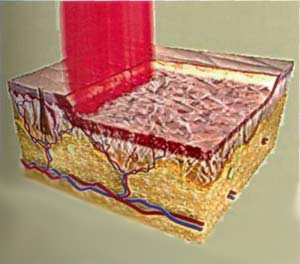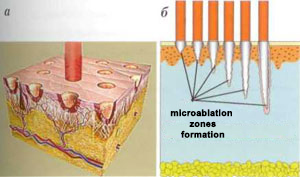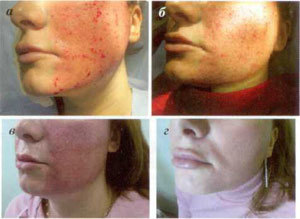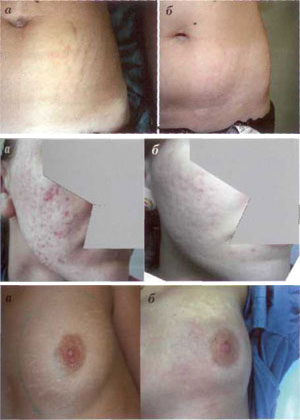Nowadays, in the arsenal of modern dermatology, there are quite a wide range of methods to correct various aesthetic skin blemishes-chemical peeling, mechanical dermabrasion, laser resurfacing, microdermabrasion, contour shaping. However, beautyNew directions and new technologies in the industry are constantly developing and improving.
This trend is especially true for hardware methods, especially laser medicine. The first use of lasers in dermatology and then the use of lasers in cosmetology has an impressive period. Even one of the latest appearance laser treatments-selective photopyrolysis-has been over 25 years. Americans RR Anderson and JA Parrish are pioneers in this direction. They pre-determined the fate of fractional lasers in medicine, making it an indispensable part of the aesthetic treatment of skin defects such as capillary hemangioma. Port wine stains, high troubles, tattoos, rosacea, pigmentation disorders, photoaging, wrinkles, etc.
Modern skin remodeling technology
We live more ages than ever before. Considering that many of them continue to live active lives, one of the most important issues in aesthetic medicine is to fight aging skin.
Plastic surgery can restore facial shape by removing excess skin. However, at the same time, the skin still changes due to time (age-related aging) or external factors (photoaging). What most patients want is also important to look younger without surgery
Which method should be used in this case to affect the skin, and what should happen in it if it is truly rejuvenated?
All the methods that can be used to improve the appearance of the skin are combined according to one principle-they have a traumatic effect on the skin, cause fibrosis, and further lead to its tension and firmness.
Currently, skin beauty uses three main types of skin reshaping effects, including:
- Chemical stimulation-chemical peeling with acid (trichloroacetic acid, glycolic acid, etc. );
- Mechanical stimulation-mechanical peeling, microdermabrasion, mesotherapy, fillers, acupuncture;
- Thermal stimulation-laser ablation, thermal lift using laser and broadband light source, radio frequency lift, fractional method.
Chemical stimulation
Historically, acid exfoliation (peeling) was the first way to rejuvenate the skin. The principle of peeling is partial destruction of the epidermis (such as surface peeling) or almost complete (such as middle and deep peeling), damaging fibroblasts and dermal structure. This damage activates the inflammatory response (the stronger, the greater the volume of the damage itself), which leads to the extra production of collagen in the skin.
However, in order to obtain the desired result, peeling must sacrifice the epidermis. The burn experiment misled many people and allegedly "proved" that the epidermis is a self-renewing organ that can quickly restore damaged skin. Area. In this regard, peeling is becoming more and more aggressive to the epidermis (for example, deep phenolic peeling), until eventually the accumulated problems make the experts aware of the malignancy of this situation and ultimately lead to the method of skin thinning.
The proponents of deep peeling ignored the emerging issues. The essence is that due to the destruction of the dermal papilla and the weakening of nutrition, the epidermis becomes thinner, and the number of cells in the spinous layer is significantly reduced. The look before peeling. The reduced barrier function of the stratum corneum leads to reduced skin hydration. (Therefore, almost all patients who have undergone deep peeling for a long time will have severe skin dryness). At the same time, introducing it into the shallower peel (using trichloroacetic acid and fruit acid) did not achieve the hope of effective skin tightening.
Mechanical stimulation
In the method of mechanically stimulating the inward changes of the skin, the use of rotating equipment (speed v; the rotation speed of the knife up to 100, 000 rpm) for skin grinding deserves special attention. Currently, using modern Schumann-Schreus equipment (Germany)This method can only be used in surgical hospitals because the process requires anesthesia, postoperative treatment of the wound surface, special toilets for the eyes and mouth, and for feeding patients (due to obvious postoperative edema 2-3 days after surgery, So it is difficult to open your eyes and mouth).
This method is very effective, but unfortunately, the use of mechanical skin dermabrasion has a high risk of the following complications:
- Persistent postoperative hyperemia;
- When the cutter penetrates the basement membrane, the appearance of pigmented areas due to the destruction of melanocytes;
- Wound surface infection;
- Scar (if the cutter is too deep into the skin)
All the above factors determine the limited application of this method in clinical practice.
Thermal stimulation
Ablative Reshaping
Since the late 1980s, lasers have been used to rejuvenate the skin through layer-by-layer tissue removal (ablation) [4]. The use of carbon dioxide laser to remove the surface layer of the skin carefully and with low trauma can stimulate the synthesis of the skin's own collagen, and its amount will increase several times after the operation. Then gradually reorganize.
The most effective method is to use a CO2 laser. When it is subjected to deep heat on all layers of the dermis, it appears as a skin tightening effect on the outside. This method is called "laser dermabrasion" or "laser resurfacing". As far as efficiency is concerned, no other method can rejuvenate the skin at the time (Figure 1).

Figure 1. Traditional laser skin resurfacing program (laser skin resurfacing)
However, CO2 laser can also cause a lot of complications. In addition, further studies have shown that this deep effect on the dermis can stimulate the formation of fibrous tissue more than promoting new, normal synthesis. Oriented collagen [5]. Advanced fibrosis can make the skin look abnormally fair. The collagen synthesized after treatment will be absorbed after a few years, just like any collagen formed in the scar. Due to the thinning of the epidermis caused by the atrophy of the papillary layer of the dermis, fine wrinkles begin to appear on the skin.
As the barrier function of the stratum corneum is weakened, the hydration level of the skin is reduced, and it appears to shrink.b Aluminum Yttrium Garnet-Laser appeared a bit later. The advantages of laser lasers are that the thermal penetration depth is shallower (the penetration depth of the er laser is 30μm, and the maximum penetration depth of the CO2 laser is 150μm) and (therefore) the risk of burns and tissue carbonization is low, and it is relatively cheap (with carbon dioxideCompared with lasers) has attracted the attention of many experts around the world.
However, with the accumulation of experience using these two types of equipment, experts have considered that the CO2 laser is more efficient [6]. Although the aforementioned carbon dioxide laser microdermabrasion has negative effects, this method is still essential to correct acne scars. In addition, it can be considered as an alternative to surgical skin tightening-in all its remodeling methods, only exposure to CO2 laser can really cause obvious skin tightening. Collagen contraction has a significant clinical lifting effect.
The problem with all the above methods is that they often "sacrifice", that is, significantly damage the epidermis. In order to restore your skin's youth and truly youthfulness, you need a natural perfect epidermis. Dermal papilla, good hydration, normal skin tone and elasticity. The epidermis is a very complex and highly specialized organ with a thickness of up to 200 microns. This is our only defense against negative environmental factors. Therefore, no matter what method we take to rejuvenate the skin, we need to ensure that the normal structure of its foundation will not be damaged. The concept of
promoted the emergence of non-ablative skin remodeling techniques.
Non-ablative reshaping
The most common equipment used for non-ablative skin remodeling is neodymium (Nd-YAG) and diode lasers, as well as broadband light sources (IPL). Its principle of action-selective photopyrolysis-includes heating and destroying the structure, and contains sufficient amounts of melanin or oxyhemoglobin. In the skin, they are the accumulation of melanocytes (lentils, melasma) and capillaries (telangiectasia). The emission wavelength used in the non-ablation laser is the maximum value corresponding to the absorption spectrum of oxyhemoglobin or melanin. The process of treatment with non-ablative laser and IPL is very safe and the recovery period is the shortest. However, this treatment only eliminates pigment and blood vessel appearance defects. In this case, the skin will thicken to a certain extent, but the effect is short-lived.
Local skin remodeling technology
The constant search for new efficient and safe skin rejuvenation methods has led to the emergence of a revolutionary technology-fractional release of laser radiation. The proposed skin rejuvenation method is specially designed to overcome some of the above difficulties. Unlike the "conventional" ablative and non-ablative laser methods that aim to uniformly thermally damage the skin at a specific depth, the fractional method can be implemented to achieve selective microscopic thermal damage in the form of multiple variations of the column, and in these microscopicLeave an unaffected area around the wound. Currently, the industry produces two types of fractional lasers: non-ablative lasers and ablation.
The first use of doped fiber, the fiber will generate 1550 nm wavelength radiation. Fractional lasers form thousands of micro-damages in the skin, in a columnar shape-micro heat treatment zone (MLZ)-diameter of 70-150mk and depth of 1359 mcm
As a result, about 15-35 skins were photocoagulated on the treatment area. The chromophore of the laser is water, and condensation mainly occurs in the lower layer of the epidermis and dermis. The stratum corneum remains intact because it contains a relatively small amount of water, which greatly reduces the risk of infection. Due to the small size of the lesion and the short migration distance of keratinocytes, the epidermis recovers quickly. The healing period is accompanied by moderate edema and hyperemia on days 5-7, followed by scaling. The patient hardly lost social activities.This technology-Fractional Photopyrolysis (FF)-is a highly effective method for non-ablative fractional skin remodeling. In order to achieve the desired effect, a course of treatment is prescribed. According to the clinical situation, it is recommended to take 3 to 6 steps with an interval of 4-6 weeks. As with any other non-ablative skin remodeling method, the final result (cumulative effect) can be seen only 4-8 months after surgery.

If you need a more aggressive effect on the skin-in order to correct scars, remove deep wrinkles and excessive skin, you can use fractional ablation (FA or deep skin ablation-FDDA) method. The
fractional ablation method combines the advantages of CO2 laser with the fractional principle of laser radiation transmission. In contrast to the traditional CO2 laser which removes the entire skin surface layer by layer, the FA unit forms a large amount of micro-ablation area (MAL) with a vaporization depth of 350 to 1800 µm, with a maximum diameter of 300 µm (Figure 2).
Therefore, during this process, the laser radiation penetrates into the deep layers of the skin, thereby destroying the upper layers of the epidermis. In terms of efficiency, the ablative fraction laser rejuvenation can be compared with plastic surgery, which is the depth to which the laser beam resurfaces.
Figure 2. Working principle of ablation fractional laser: formation of micro-ablation zone-MAZ (a); dependence of MAZ formation depth on laser radiation power (b)
Like FF, the skin of the treated area is actually exposed 15% to 35% (in some cases, up to 70%). The recovery after FA surgery is faster than the recovery after layer-by-layer ablation. This is due to the fact that part of the epidermis and stratum corneum remain intact. Skin bleeding was observed for a period of time after the operation, but it stopped soon (Figure 3a, b).
Figure 3. Gradual skin repair after fractional ablation surgery: check immediately after treatment (a); every other day (b); 5 days later (c); 14 days after one operation (d)

A large number of micro-bleeds appear in the dermis. These micro-bleeds cause a series of complex changes, leading to the production of new collagen. After the bleeding stops, it is necessary to remove the serum remaining on the skin surface. Its release was observed within 48 hours after the operation, until the microablation area was completely epithelialized. During this period, the patient uses a special wound healing topical medicine. Peeling and swelling increase usually from 3-4 days (Figure 3c). By day 7, these phenomena gradually subsided, and erythema was still the only obvious side effect (Figure 3d). The duration of erythema depends on the parameters of laser irradiation and the characteristics of skin blood vessel formation. According to the author's observation, erythema lasts no more than 3 months.
The patient’s loss of social activity after FA surgery lasts for 5 to 10 days.
In order to prevent scar formation and post-inflammatory hyperpigmentation, it is necessary to take care of the skin carefully. Decorative cosmetics can be used for 4-5 days. The prerequisite for good results is at least 3 months after using highly protective sunscreen cosmetics (SPF of at least 50). The risk of post-inflammatory hyperpigmentation occurs in 20% of patients, with skin patients usually having a higher type IV-V. This pigmentation is short-lived in nature and can last from 1 week to 3 months, depending on the depth of treatment and the area of treatment. Prophylaxis 1-2 weeks before the operation and two weeks later, topical drugs based on hydroquinone (4%) and tretinoin (0. 1%) are prescribed. The main effects of FA surgery on facial skin are as follows: significantly tighten and reduce excess skin, smooth wrinkled skin on the surface, and skin affected by acne scars, reduce color aberration and pores.
This method has been tested by the author and his colleagues and can remove stretch marks on the skin. As shown in clinical studies, this method has proven to be highly effective in eliminating almost all types of stretch marks obtained during puberty. Period and postpartum. Note that the healing process of human skin is different from that of facial skin.
The mechanism of skin remodeling when using fractional laser
Let us consider the mechanism of skin remodeling when using fractional laser.
After exposure to laser, aseptic inflammation develops in the microwound area formed. The more aggressive the laser irradiation, the more obvious the inflammatory response, which actually stimulates the release of growth factors and fibroblasts after trauma to infiltrate the damaged tissue. The impending reaction is automatically accompanied by a burst of cell activity, which inevitably leads to the fact that fibroblasts begin to produce more collagen and elastin. The skin remodeling process includes three classic regeneration stages:
- Phase I-Change (tissue inflammation). Start immediately after damage;
- Stage II-Proliferation (tissue formation). Start 3-5 days after injury and last about 8 weeks;
- Phase III-Organizational Remodeling. Lasts from 8 weeks to 12 months.
It should be noted that all three stages of skin remodeling were observed after partial photopyrolysis and partial ablation. But in the first case, the damage effect of the laser is moderate, and the result is that a series of inflammatory changes will never be too crazy.
A completely different image was observed after exposure to a partial ablation laser. The laser-induced trauma ruptures blood vessels, and blood cells and serum are released into the surrounding tissues. The mechanism of mature skin regeneration-phase change begins-aseptic inflammation develops. Platelets released from damaged blood vessels play an important role in activating blood clotting and releasing chemical toxic factors. In turn, other platelets, leukocytes and fibroblasts are also attracted. White blood cells, especially neutrophils, participate in the cleaning of damaged tissues and remove the debris of necrotic tissues. These debris are partially destroyed by phagocytes and partly destroyed by phagocytes. It appears on the skin surface in the form of microscopic fragments composed of epidermis and dermal tissue matrix and melanin-micro-epidermal necrotic fragments (MENO).
The proliferation phase begins in about 5 days. During this period, neutrophils are replaced by monocytes. Monocytes, keratinocytes, and fibroblasts continue to affect growth factors, while at the same time being affected by the opposite. Keratinocytes stimulate the growth of the epidermis and stimulate the release of growth factors necessary for fibroblasts to produce collagen. At this stage, new blood vessels are formed and the extracellular matrix is densely formed.
The last stage of reconstructive healing after partial laser irradiation lasts for several months.
On the 5th day after injury, the fibronectin matrix "always" the fibroblasts and forms a "fit" of the axis of collagen. Transforming growth factor β plays an important role in the formation of this matrix (TGF-β is a strong chemical toxin for fibroblasts) and other growth factors. The main form of collagen in the early stage of wound healing is type III collagen (this type of collagen is located in the upper layer of the dermis, just below the basal layer of the epidermis). The longer the metamorphosis stage, the more type III collagen is produced, but in any case, the amount is the highest 5 to 7 days after injury. After about a year, type III collagen is gradually replaced by collagen type I, which can enhance skin strength. The blood circulation gradually normalizes, the skin becomes smoother and acquires a natural color.
Comparative analysis of laser skin reshaping methods
Summing up the above content, we provide you with a schematic diagram showing the relationship between the effectiveness and safety of the laser skin reshaping method.
The advantages of the score track revival method. The advantages of using the fraction method in clinical practice include:
- controls the skin with minimal damage. Histological studies performed after surgery showed an increase in the number of papillae in the dermis, which characterizes the changes that occur in the skin as a productive regeneration;
- Effectively rejuvenate: the skin becomes thicker, and the production of collagen and elastin increases significantly (over 400% (! ));
- Short healing time: an average of 3 days after FF, an average of 7-14 days after PA;
- Pigmentation risk is minimal;
- Possibility of performing surgery in patients with thinner skin;
- has the ability to heal any part of the body;
- Possibility of using light anesthesia: when using partial photothermal lysis, only local application anesthesia is used; for partial ablation, a combination of conduction anesthesia and infiltration anesthesia is required;
- The dilatation of capillaries disappeared (because the blood vessels ruptured in many places and could not be repaired).
Main indications for some treatments

Indications of fractional photopyrolysis:
- Skin density increases in the early stages of aging. FF surgery is relatively easy and can be performed without worry. Can have a therapeutic effect on the neck, abdominal cavity, arms, abdomen, thighs, and breast;
- Skin photo-aging;
- Pigmentation, chloasma;
- Hypertrophic scars;
- Stretch marks
Indications for fractional ablation:
- Wrinkles of varying severity-from fine lines to strong and obvious wrinkles (in the form of grooves);
- Age-related decrease in skin elasticity and firmness;
- Excess skin on the eyelids, neck, and face (as an alternative to plastic surgery);
- Uneven skin texture;
- indicates that the skin is photoaging;
- Acne scars;
- Injury, skin scar deformity after surgery;
- Hyperpigmentation: chloasma, chronic disease, spot-like pigmentation, etc.
- Dysplasia of blood vessels;
- skin stretch marks;
- Actinic Keratosis
In short, I just want to say a few words about the prospect of using laser technology in aesthetic medicine. We must pay tribute to the manufacturers, who are beginning to pay more attention to the safety of medical procedures using lasers. Technology continues to evolve. However, the safety of this method is often sacrificed in order to improve its effectiveness. Or vice versa. A compromise was found in the new principle of delivering laser radiation to the tissue. It should be noted that the laser remains unchanged: carbon dioxide, neodymium. This means:
- First of all, laser skin reshaping is recognized as the most effective method today;
- Secondly, the coverage of aesthetic and dermatological problems solved by these methods is very wide-from skin rejuvenation to the treatment of congenital and acquired skin diseases;
- Third, with the advent of fractionation technology, the safety and effectiveness of treatment have become predictable.















































































